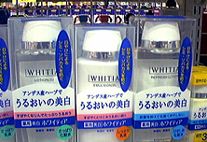|
Top Picks || Arts & Entertainment || Business & Economy || Education & Society ||
FAIR-SKINNED TEENS: A Return to Tradition or a Symbol of Anxiety? January 21, 1999  Cosmetics makers offer a wide lineup of skin-care products that claim to whiten the skin. There is an old saying in Japan relating to its traditional sense of beauty that goes, "Fair skin can make up for defects." Most young people today are probably unfamiliar with this expression, but lighter skin is nonetheless returning to vogue. High school girls, many for whom up until recently visits to tanning salons have been routine, are now flocking to pharmacies seeking out makeup that lightens their complexion. The sun has become an enemy, and high-protection sunscreen, rather than tanning oil, has emerged as the skin lotion of choice. There are those who believe, however, that this revival of a traditional look signifies a shadow of unease looming over society. The Changing Color of Skin In the 1990s many cosmetic makers developed more effective formulas for enhancing white skin; as a result, today's products are better than ever before. Moreover, competition in this market has brought prices down to attractive levels for younger consumers. According to one drugstore manager in Shibuya, a district at the cutting edge of Tokyo fashion, a "fair-skin" corner was established in June 1998, and sales began taking off around August. At some aesthetic salons, a cosmetic procedure called "chemical peeling" is offered. This method uses a type of acid to melt the skin's keratin, enhancing whiteness. The process is expensive, but popular nonetheless. Over the last several years, light-brown has been the skin color to be emulated among young women. The summer tan has certainly been in for some time, most notably during the surfer boom of the 1980s, but recently women had been turning to salons to maintain their tans even during the winter months. And the influence of Namie Amuro, a wildly popular pop singer and dancer who sparked the amuraa phenomenon of young girls imitating her look, was also a major factor in the tanning craze; the most salient features of this look were long, dyed-brown hair, a miniskirt and boots to accentuate long, slender legs, and a healthy, brown tan.
A Symbol of Social Distress? The pursuit of fair skin up to now has primarily been the domain of middle-aged women anxious about the telltale signs of aging--not usually a concern of teenagers. But many young women who up to last year held memberships to tanning salons now open parasols when they walk out into the sunlight for fear of spots and wrinkles. In this age of extreme sensitivity toward appearance, is the fairer look just another fleeting fashion phase, or could it be a genuine return to tradition?
 Edited by Japan Echo Inc. based on domestic Japanese news sources. Articles presented here are offered for reference purposes and do not necessarily represent the policy or views of the Japanese Government. Edited by Japan Echo Inc. based on domestic Japanese news sources. Articles presented here are offered for reference purposes and do not necessarily represent the policy or views of the Japanese Government.
|
